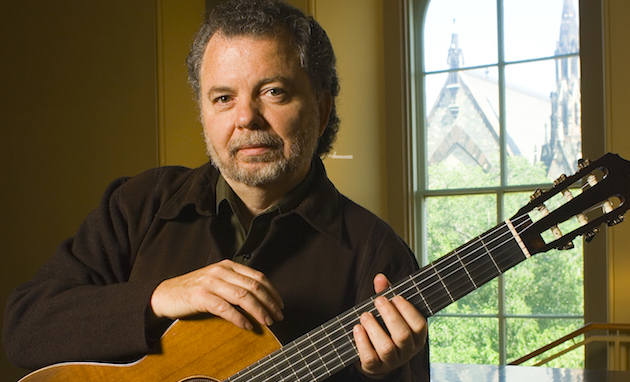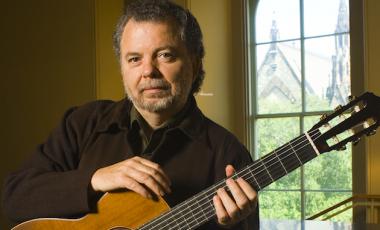
The Cuban guitarist Manuel Barrueco is the quintessential classical artist probing the masterpieces of the past for new insights. He has spent the better part of his 40-odd-year career probing the masterpieces of the past for new insights, as he did, masterfully on Sunday in a recital at Herbst Theater for San Francisco Performances and the Omni Foundation for the Performing Arts.
The substantial program was devoted to Baroque and Classical music, as well as works long associated with the 20th-century Spanish virtuoso Andres Segovia. Particularly remarkable was a powerful and moving performance of Johann Sebastian Bach’s monumental Chaconne.
Recently some scholars have come to believe Bach wrote the the Chaconne in response to the death of his first wife, Maria Barbara. Barrueco, who has been playing this music since he was 12 years old, returned to the piece and made this arrangement after the death of his parents. The longest individual movement Bach wrote for a solo instrument (the original is for the violin), the Chaconne portrays the entire gamut of human experience from profound contemplation to perfect serenity and from anguished sorrow to exuberant joy.
Segovia gave the first performance of the Chaconne arranged for the guitar in a 1935 Paris recital. He added bass notes and thickened textures to take advantage of the guitar’s natural resources in a manner similar to his great contemporary Ferruccio Busoni in his famous arrangement of the Chaconne for piano. Most contemporary guitarists take a very different approach and perform only the notes Bach wrote for violin but the result is often criticized as lacking resonance and character. There is now a burgeoning interest in the Busoni/Segovia tradition of creative arrangement and Barrueco comes down firmly on this side of the debate. While his choices and performance provide maximum clarity and avoid the muddy textures that many feel mar Segovia’s performance, they also provide the power that comes from idiomatic textures and allow his understated yet very personal and moving interpretation to emerge.
Barrueco set the stage for the Chaconne by opening with Sylvius Leopold Weiss’ Suite in D minor, a collection of dances similar in style to the Bach Cello Suites. Barrueco was always sensitive to the rhythm and affect of the Baroque dances. His counterpoint was a model of clarity, his melodic ornamentation was elegant, and his tone pure and expressive.
Fernando Sor’s Variations on a Theme of Mozart, Op. 9 is based on a song from his contemporary’s Magic Flute, sung by the bird catcher Papageno as he plays his magic bells to charm wild beasts. Barrueco evoked an orchestral palette in the introduction, and perfectly characterized the playful, delicate aria and five memorable variations with rhythmic sensitivity.
Federico Moreno Torroba and Joaquín Turina were the first established composers to answer Andrés Segovia’s call for a modern guitar repertoire. Torroba’s Suite Castellana, which is named after the old Spanish kingdom that ruled medieval Spain, is in three movements.. In Barrueco’s hands, the Fandango was dramatic and mysterious; Arada, with harmonies influenced by Debussy, was gently expressive; and the Danza provided a boisterous finale. Turina’s Fandanguillo, Soleares, and Rafaga paint a very personal and impressionistic portrait of Spanish flamenco music. Segovia’s much imitated interpretations make a great deal out of the folkloric roots of the music. Barrueco took a very different approach emphasizing Turina’s love of impressionism and a reflective attitude toward flamenco with an intimate interpretation, which included the softest and most expressive strummed rasgueado chords, I have ever heard.
Isaac Albéniz’s Suite Española is made up of pieces, written for piano over a period of many years, which depict the different musical styles of Spain. In Sunday’s recital, two movements, Cataluña and Sevilla, were given breathtakingly virtuosic and stylish readings and were joined by Mallorca, a heartbreaking serenade. The enthusiastic audience was treated to an encore performance of the heartfelt Scherzino Mexicano by the Mexican composer Manuel Ponce.

